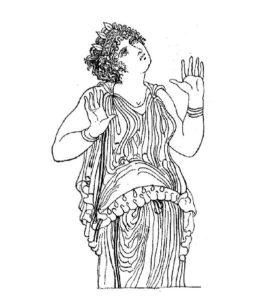
Credit: Pexels.com
Margaret Atwood’s earthy poem, “Death of a Young Son by Drowning,” perfectly captures the life-altering heartache that comes after the loss of a child. Atwood’s words are abundant in texture, and her similes are bitingly accurate. This lends the poem a strong sense of realism, even as some of the metaphors take on a surrealist quality. Losing a child is a complicated and chaotic experience that is almost too difficult to put into words. Yet in “Death of a Young Son by Drowning,” Atwood manages to capture its unique haziness and deep grief.
The poem centers around the internal struggle of the narrator, a woman who has just lost her son in a drowning accident. It opens with a stunning metaphor for birth that connects directly to the accident. Atwood writes:
He, who navigated with success
the dangerous river of his own birth
once more set forth
on a voyage of discovery
into the land I floated on
but could not touch to claim

The Greek goddess Gaia.
Credit: Wikimedia.org
Here, Atwood finds a touch of irony in the son’s death. A young boy who had fairly recently “navigated” the “dangerous river of his own birth” (the birth canal) has his life quickly taken by a much larger, much more literal version of that river. Water is a life-giving substance, but as Atwood implies here, it also has the power to take life away. It’s a nuanced example of “Mother Earth.”
As the poem continues, Atwood muses on what the son might be seeing as he dies. Here, she takes a cyclical approach to death and the afterlife. Atwood writes that the son has become an adventurer, looking at a landscape that everyone has seen before, yet few remember. It’s not completely clear whether Atwood is referring to birth or death in this stanza, but the effect is the same. Everyone is born, and everyone dies. We all eventually return to that nebulous place of nonexistence.
However, “Death of a Young Son by Drowning,” goes much deeper than a discussion on grief and child loss. In one stanza, Atwood alludes to the Greek god Uranus, whose name loosely means “to rain.” Uranus was the son of Gaia (Mother Earth). According to Greek mythology, after Uranus dies, his blood mixes with the earth (Gaia) and creates new life. Here, Atwood reaffirms the cyclical nature of life and death and the role that mothers play in each.

Credit: Pixabay.com
The world keeps turning, even after the loss. As Atwood writes:
It was spring, the sun kept shining, the new grass
leapt to solidity;
my hands glistened with details.
In this stanza, we clearly see the struggle between the life cycle and death. And in a larger sense, we also see the struggle between motherhood and personhood. Although the child is gone, life continues. Similarly, although the narrator is now a bereaved mother, her life still extends beyond that role. The message of “Death of a Young Son by Drowning” is clear: Even after intense, heart-shattering grief, life goes on.

 “Death of a Young Son by Drowning” by Margaret Atwood
“Death of a Young Son by Drowning” by Margaret Atwood


 “As Tears Go By” by Marianne Faithfull
“As Tears Go By” by Marianne Faithfull

 Funeral Favors Offer Visitors a Tangible Memento
Funeral Favors Offer Visitors a Tangible Memento















